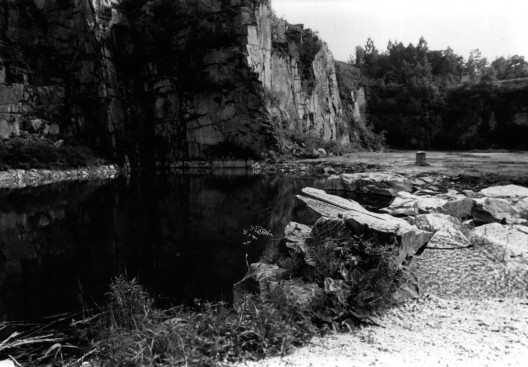Patrick Greaney on a photograph by Heimrad Bäcker
This undated photo by Heimrad Bäcker shows the Wiener Graben, a quarry in the Mauthausen concentration camp. Hundreds of times, from 1968 to the mid-1990s, Bäcker made the half-hour trip from his apartment in Linz to Mauthausen, where he photographed the deteriorating ruins that surrounded the official memorials.

Mauthausen’s site was chosen because of the quarries there, whose granite the SS intended to use in the construction of a new Linz, which, after the annexation of Austria in 1938, was one of the many German cities selected as “cities to be redesigned” (Neugestaltungsstädte) and, later, one of the five “cities of the Führer.” Reshaping German cityscapes and landscapes belonged to the Nazi plan to give a new, beautiful form to the German race. Eugenics and land art went hand in hand.(1)
In an essay about Bäcker’s photos, Klaus Amann reproduces a photo of the Wiener Graben from the richly illustrated 1939 book The Upper Danube: The Home of the Führer.(2) Taken during the Nazi operation of the camp, it captures the dynamiting of the same wall later photographed by Bäcker. Amann notes the absence of laborers in the Nazi-era photo: “It’s as if nature were working on itself.”

That’s the point of The Upper Danube. It tries to demonstrate the naturalness of German architecture and art, to display the beauty of the Germans who live in the landscapes where they belong, and to erase the presence of the labor that transforms nature into culture. In the book’s first pages, the author praises the smooth transition between “virginal, mysterious ancient landscapes and completely formed and well finished architecture.” And he claims that “German essence can’t be separated from the German landscape.”(3) After reading The Upper Danube, the phrase “Blut und Boden” seems pleonastic. For its author, blood is soil, soil blood.
What’s the difference between the two Wiener Graben photos reproduced here? One was shot from above the quarry and one from within. Bäcker’s seems melancholic and pastoral, while the other depicts a scene that’s monumental and static despite its depiction of an explosion. But there is nothing in the 1930s photo that signals its fascist history, and nothing in Bäcker’s that indicates a critical stance.
Perhaps that stance emerges only when discussing Bäcker’s photos. Even a basic description of them requires some historical knowledge about the Shoah. This obligation may be their critical, political content, which is realized only in interpretation. In this way, his works are like Bernd and Hilla Becher’s photos of an industrial architecture whose forms have become foreign. To understand the Bechers’ works, an interpreter must “learn the language of industrial engineering: pithead towers, coke ovens, engine houses, gas compressors, central shafts, consolidation collieries, twin-strut frames and steel headgear.”(4) To talk about Bäcker’s photos, one must understand something of the slave labor practices and mass killings in Mauthausen, since his works often include objects and sites whose functions, when named, evoke that history. The photos themselves, however, tell the viewer nothing about what they show. It’s tempting to read their gray melancholia as an allegory of this muteness, as an attempt to signal the presence of critique and to express suffering.
But if art was such a central part of the Nazi project, then why, in Bäcker’s photos or, really, any photo, would one still look for a guarantee of the presence of critique? How could art ever be critical in and of itself? How could it rid itself of its intimacy with fascism? Since art and aesthetics served the Nazis so well, it’s hard to pretend that art is on an antifascist outside looking in at their crimes. Bäcker’s photos are about this problem.
Photo 1: Heimrad Bäcker, Wiener Graben in Mauthausen, undated, 8,25 x 11,6 inches, Courtesy of Michael Merighi
Photo 2: Robert Stenzel, Steinbruch bei Mauthausen an der Donau, from Rudolf Lenk, Oberdonau: Die Heimat des Führers, page 55 (see note 3 below)